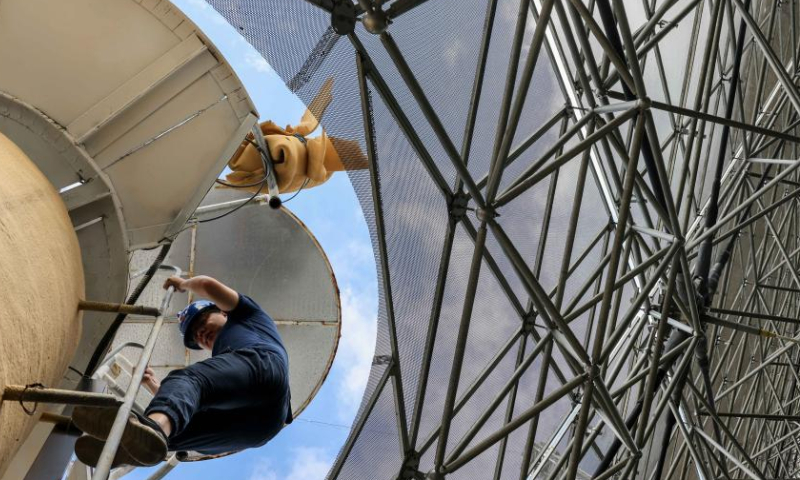
Aerial panoramic photo taken on July 21, 2022 shows China's Five-hundred-meter Aperture Spherical Radio Telescope (FAST) under maintenance in southwest China's Guizhou Province. Using FAST, also dubbed as the "China Sky Eye," scientists have identified over 660 new pulsars since October 2017. Photo: Xinhua

Photo taken on July 22, 2022 shows a staff member going down from China's Five-hundred-meter Aperture Spherical Radio Telescope (FAST) under maintenance in southwest China's Guizhou Province. Using FAST, also dubbed as the "China Sky Eye," scientists have identified over 660 new pulsars since October 2017. Photo: Xinhua

Staff members perform a regular maintenance operation on the Five-hundred-meter Aperture Spherical Radio Telescope (FAST) in southwest China's Guizhou Province on July 20, 2022 Using FAST, also dubbed as the "China Sky Eye," scientists have identified over 660 new pulsars since October 2017. Photo: Xinhua

Aerial photo taken on July 21, 2022 shows China's Five-hundred-meter Aperture Spherical Radio Telescope (FAST) under maintenance in southwest China's Guizhou Province. Using FAST, also dubbed as the "China Sky Eye," scientists have identified over 660 new pulsars since October 2017. Photo: Xinhua

Aerial photo taken on July 21, 2022 shows China's Five-hundred-meter Aperture Spherical Radio Telescope (FAST) under maintenance in southwest China's Guizhou Province. Using FAST, also dubbed as the "China Sky Eye," scientists have identified over 660 new pulsars since October 2017. Photo: Xinhua

Aerial photo taken on July 21, 2022 shows China's Five-hundred-meter Aperture Spherical Radio Telescope (FAST) under maintenance in southwest China's Guizhou Province. Using FAST, also dubbed as the "China Sky Eye," scientists have identified over 660 new pulsars since October 2017. Photo: Xinhua

Aerial photo taken on July 21, 2022 shows China's Five-hundred-meter Aperture Spherical Radio Telescope (FAST) under maintenance in southwest China's Guizhou Province. Using FAST, also dubbed as the "China Sky Eye," scientists have identified over 660 new pulsars since October 2017. Photo: Xinhua

Photo taken on July 21, 2022 shows China's Five-hundred-meter Aperture Spherical Radio Telescope (FAST) under maintenance in southwest China's Guizhou Province. Using FAST, also dubbed as the "China Sky Eye," scientists have identified over 660 new pulsars since October 2017. Photo: Xinhua

Staff members check reflector panels during a regular maintenance operation on the Five-hundred-meter Aperture Spherical Radio Telescope (FAST) in southwest China's Guizhou Province on July 22, 2022 Using FAST, also dubbed as the "China Sky Eye," scientists have identified over 660 new pulsars since October 2017. Photo: Xinhua

A staff member performs a regular maintenance operation on the Five-hundred-meter Aperture Spherical Radio Telescope (FAST) in southwest China's Guizhou Province on July 21, 2022 Using FAST, also dubbed as the "China Sky Eye," scientists have identified over 660 new pulsars since October 2017. Photo: Xinhua
